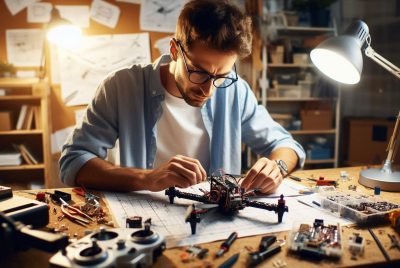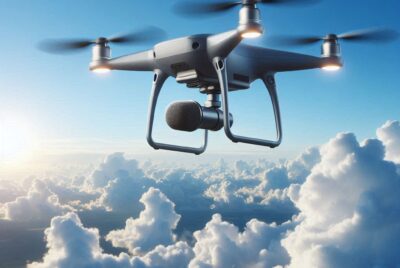Drone Propellers: Enhancing Aerial Performance
*We may earn a commission for purchases made using our links. Please see our disclosure to learn more.
Drone Propellers: Enhancing Performance with Advanced Designs
Drone propellers are an essential component of any unmanned aerial vehicle (UAV), playing a crucial role in their ability to fly. Each propeller generates thrust by spinning and pushing air down, allowing the drone to ascend, descend, hover, and maneuver. The design and material of the propellers greatly affect the drone’s performance, making it important to choose the right ones for specific tasks. Whether for professional use in filmmaking, agriculture, inspection, or for hobbyists enjoying flying and racing, propellers are key to a drone’s operation.

I understand the importance of propellers not just as replaceable parts but as integral to a drone’s efficiency and handling. Advanced materials used in propeller construction such as carbon fiber or lightweight plastics improve durability and reduce weight, enhancing flight times and responsiveness. Mastering propeller-related knowledge is crucial for anyone interested in drone technology. I identify that the shape, size, pitch, and number of blades are all variables that affect a drone’s lift, speed, and overall aerial capabilities.
In my experience, maintaining drone propellers is also an important aspect of UAV ownership. Regular inspections for damage and ensuring proper installation maximizes safety and performance. Understanding how to replace and balance propellers can save time and money while helping pilots achieve the best possible flight experience. Whether interested in aerial photography or drone racing, knowing about propellers gives drone pilots an edge in optimizing their craft for desired outcomes.
The Basics of Drone Propellers

In my exploration of drone technology, I’ve learned that propellers are critical components that determine a drone’s flight capabilities. Here, I’ll break down their design and the materials used for optimal aerodynamics and durability.
Propeller Design and Aerodynamics
Propeller effectiveness hinges on their aerodynamic design. The shape and length of the blades, in conjunction with their diameter and propeller pitch—the angle at which blades slice through the air—significantly impact lift generation. Ideal propeller design ensures that as the blades rotate, they create a pressure difference between the top and bottom surfaces. This pressure variance allows the drone to ascend or hover by pushing air downwards, leveraging Newton’s third law of motion.
- Diameter: Larger diameters provide more lift but may reduce maneuverability.
- Blade Shape: Curved blades are engineered to optimize airflow and are usually more efficient.
Lift is pivotal; without it, the drone cannot overcome gravity. My observation is that drones typically manipulate lift by varying the speed of each propeller, facilitating complex movements like pitching (tilting forward or backward) and yawing (twisting left or right).
Materials and Construction
The materials used in propeller construction matter a great deal. Propellers must be lightweight to reduce the overall drone weight, yet strong enough to endure the stresses of flight. Common materials include:
- Plastics: Polypropylene or polycarbonate are preferred for their balance of flexibility and durability.
- Carbon Fiber: Opted for high-performance drones, providing exceptional strength-to-weight ratio and stiffness.
The construction process aligns the aerodynamic design principles with material selection to create propellers that fulfill specific flight characteristics. For instance, a stiffer propeller made of carbon fiber might offer stability and precision, while a more flexible plastic propeller provides resilience against impacts. My analysis suggests that the choice of material often correlates with the intended use and cost of the drone.
Drone Propellers: Propeller Dynamics

In analyzing propeller dynamics, a concrete understanding of pitch and diameter, as well as thrust and motor compatibility, is essential to optimize performance.
Pitch and Diameter
Pitch refers to the distance a propeller would move in one complete rotation if it were moving through a soft solid, like a screw through wood. Generally, a higher pitch means more speed at the cost of additional power and torque requirements from the motors. Conversely, a lower pitch leads to better efficiency and more thrust at lower speeds.
The diameter of a propeller is the length of a single blade from tip to tip, which directly affects the amount of air displaced. Larger diameters can increase thrust and efficiency but require more power, influencing motor selection.
- Pitch: Higher values increase speed, higher power needed.
- Diameter: Larger sizes boost thrust and efficiency, more power consumed.
Thrust and Motor Compatibility
The thrust a propeller generates is contingent upon its compatibility with the motor. The motor’s RPM (rotations per minute) and torque are pivotal in determining the right propeller. A motor must be powerful enough to spin the propeller at a sufficient speed to generate the required thrust. In essence, thrust is the upward force that opposes gravity, allowing the drone to ascend and remain in flight.
Motor compatibility usually includes considering the motor’s KV rating (which dictates the rotation speed per volt), and ensuring that the power, torque, and efficiency match the requirements of the propeller’s blade count and rotation direction. Moreover, different setups may opt for varying number of blades; for example, more blades generally mean more thrust but at the cost of efficiency.
- Thrust: Depends on the propeller’s ability to displace air effectively.
- Motor compatibility: Needs matching of motor KV, torque, power, and number of blades for optimal performance.
Drone Propellers: Performance Factors

When considering drone propeller performance, I focus on how effectively they translate power into lift and control. The balance and structure of propellers are vital for maximizing efficiency and responsiveness during flight.
Balancing and Vibration Reduction
I understand that proper balancing of drone propellers is crucial for reducing vibrations, which in turn minimizes wear on the drone’s components and prevents potential control issues. Here are specific factors to consider:
- Balance: Precisely balanced propellers produce less vibration, leading to more stable flight and increased efficiency.
- Material Rigidity: Stiffer propeller materials can help maintain balance but may transmit more vibration compared to more flexible ones.
- Regular Maintenance: Checking for and correcting imbalances regularly ensures consistent performance and reduces vibrations.
Noise and Stability
Drone propellers are not just about lift; they also play a critical role in the acoustic signature and aerodynamic stability of the drone:
- Propeller Design: Thinner and sharper-edged propellers can cut through the air with less noise, but might not be as efficient at slower speeds.
- Pitch and Size: A higher pitch or larger propeller may increase drag and turbulence at higher speeds, which could lead to more noise, while low-pitch or smaller propellers might be quieter but less powerful.
- Speed Control: Keeping propellers at optimal speeds can achieve a balance between noise reduction and control, enabling responsive and stable flight.
Advanced Propeller Technologies

The leap in drone propeller technologies has primarily been driven by enhancements in aerodynamic efficiency and breakthroughs in material science.
Innovations in Aerodynamic Efficiency
I’ve observed that advanced propellers are now crafted to achieve superior stability and control. These propellers take advantage of sophisticated designs that reduce noise and increase thrust efficiency. One such innovation is the toroidal propeller, which employs a closed-form design to minimize sound, making drones significantly quieter during operation. The aerodynamic characteristics of these propellers also contribute to a more maneuverable and controllable drone flight.
- Aerodynamic Design Features:
- Closed-form shapes
- Refined blade angles
Material Advancements and Durability
In my research, carbon fiber propellers stand out due to their lightweight and rigidity, providing improved responsiveness and less flex under load. This results in both higher efficiency and longer propeller lifespan. Apart from carbon fiber, high-quality nylon propellers are also used extensively due to their impressive balance of durability and cost-effectiveness.
- Material Properties:
- Carbon Fiber: High rigidity, lightweight, durable
- Nylon: Cost-effective, resilient
In terms of performance, these materials have significantly pushed the limits of drone capabilities. Using a combination of advanced materials such as carbon fiber and nylon not only furthers the durability of drone propellers but also optimizes their aerodynamic efficiency.
Operational Considerations for Drone Propellers

In optimizing drone operations, my focus is on understanding environmental impacts and matching drone capabilities with payload demands.
Environmental Factors
When I operate drones, I account for varying environmental conditions that can affect flight performance. My experience confirms that factors like windy conditions notably influence power consumption and maneuverability. Here’s how I address them:
- Wind: Increased wind resistance can lead to higher power consumption, as the drone’s motors work harder to maintain stability. This typically reduces flight time.
- Temperature: Extreme temperatures can impact the battery performance, influencing both flight duration and drone behavior.
- Altitude: Higher altitudes with thinner air can reduce propeller efficiency, requiring more power to maintain hover.
Payload and Drone Type
The type of drone and its payload capacity are critical to efficient flight operations. Here’s what I consider:
- FPV and Racing Drones: These drones are agile and often designed for speed rather than lifting capacity. I ensure that their power-to-weight ratio is optimized for quick maneuvers and that the payload doesn’t impede performance.
- Payload Capacity: Different drones can carry varying payloads. When determining the appropriate drone for a task, I match the payload capacity to the demand, ensuring the drone has sufficient lift and power to operate effectively.
- Flight Time Considerations: I’m mindful that any additional weight from the payload reduces the flight time by increasing power consumption. This balance is essential for mission planning.
FAQs About Drone Propellers
In this section, I provide clear and specific answers to common inquiries about drone propellers — critical elements affecting your drone’s performance and maintenance requirements.
1. How do I choose the best propeller for my drone?
To select the best propeller for my drone, I consider factors such as the drone’s weight, motor capability, and intended use. I make sure that the propeller’s materials and size are compatible with my drone’s specifications for optimal performance.
2. What is the difference between 2-blade and 3-blade drone propellers?
The main difference between 2-blade and 3-blade propellers is efficiency and thrust. Two-blade propellers generally offer more efficiency and longer flight times, while three-blade propellers provide more thrust and stability but at the cost of increased power consumption.
3. How do I determine the correct propeller size for my drone?
To determine the correct propeller size for my drone, I check the manufacturer’s recommendations first. The size directly relates to the motor’s size and power rating, and using incorrectly sized propellers can lead to inefficient flight or motor damage.
4. What should I consider when buying replacement drone propellers?
When buying replacement drone propellers, I consider durability, brand compatibility, and balance. It’s crucial to purchase propellers that match the specifications of my drone and ensure they are free of imperfections to maintain the drone’s performance.
5. How do different types of propellers affect a drone’s performance?
Different types of propellers can affect a drone’s performance in terms of lift, speed, maneuverability, and battery life. For instance, propellers with a steeper pitch or more blades can generate more lift but may also require more power.
6. What maintenance is required for drone propellers?
Regular maintenance for drone propellers includes cleaning off any dirt or debris and inspecting for damages like cracks or warps. Propellers should be balanced periodically to ensure stable flight, and they should be replaced if any signs of wear or damage are visible.




